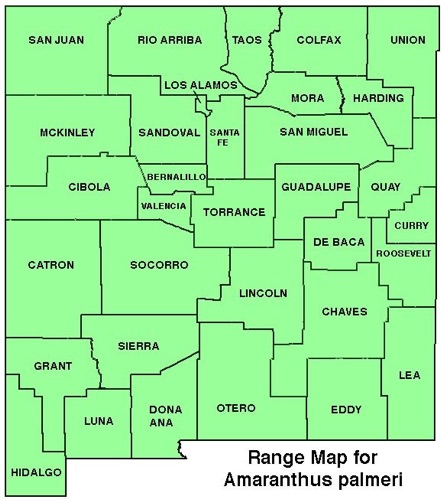WILDFLOWERS OF NEW MEXICO

Now classified as a global ”superweed” because it is resistant to all known chemical herbicides, this native of the arid Southwest thrives in cultivated fields. Though highly invasive in disturbed soils, it is not invasive in natural, undisturbed habitats. Note the erect, branching, often reddish, 3–8 foot tall stems, broad, pointed leaves, and long, whip-like, leafless flower and seed spikes that often droop. Note that the long flower spikes develop from the stem and branch tips, but not from the leaf axils. Amaranth species are commonly called pigweed.
FLOWER: May–September. Male and female flowers on separate plants (dioecious), wind-pollinated. Flowers tiny, greenish-white, in dense clusters on long, often drooping, leafless terminal spikes. Small, roundish clusters may grow from the leaf axils but not spikes. A single female plant can produce 80,000 to 600,000 tiny seeds, which are dispersed by wind, water, foraging animals, in hay and seed mixes, and other human means.
LEAVES: Alternate; leaf stalk (petiole) often longer than blade. Blade oval to diamond-shaped, 1–4 3/4 inches long (3–12 cm), tip pointed, margins entire.
HABITAT: Dry to moist soils; native to desert grasslands and scrub, shortgrass prairie, pinyon-juniper, ponderosa pine woodlands, floodplains; invades disturbed soils of roadsides, pastures, farmland, row crops.
ELEVATION: 3,700–8,350 feet.
RANGE: AZ, CA, CO, LA, NM, NV, TX, UT; invasive in 20+ midwestern southern and northeastern states, especially croplands.
SIMILAR SPECIES: Twelve native and seven introduced species of amaranth in NM, many with minuscule differences. Green pigweed, A. hybridus, naturalized in NM from the eastern U.S. occurs nearly statewide. It has male and female flowers on the same plant, and shorter, thicker, erect flower spikes that grow from both the leaf axils and the stem and branch tips.
NM COUNTIES: Widespread statewide in low- to mid-elevation habitats.
NOTES: With nutritious leaves and seeds, Palmer’s amaranth was an important source of food and medicine for Native Americans, but ironically in modern times seriously diminishes global food sources. It has developed enzymes that neutralize all known chemical herbicides, and can reduce yields of corn, cotton, peanut, sorghum, and soybean by up to 94%. It has spread to all continents except Antarctica. A USDA Weed Risk Assessment study (2020) that considered climate factors predicted it could become established in 81% of the USA. It and other herbicide-resistant weeds present a major threat to the economic future of large-scale, row-crop agribusiness dependent on chemical weed control.

PALMER’S AMARANTH, CARELESSWEED
AMARANTHUS PALMERI
Amaranth Family, Amaranthaceae
Annual herb



THE CONTENTS OF THIS WEBSITE ARE COPYRIGHTED AND CANNOT BE USED
WITHOUT PERMISSION OF GEORGE OXFORD MILLER
EMAIL ME



Arching spikes grow from stem and branch tips; only small, rounded clusters grow from leaf axils.
Male flower with pollen producing stamens. Female flowers grow on separate plants.
Stems often turn red.
Diamond-shaped leaves have stalks (petioles) often longer than the blade.

Leafy plants reach 3–8 feet tall and can grow in dense colonies in disturbed soils, like row crops.
